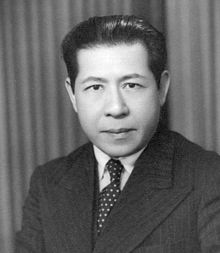- Chen Gongbo
-
Chen Gongbo
陳公博
President of Republic of China
(Nanjing regime)In office
September 1944 – August 1945Preceded by Wang Jingwei Succeeded by Office Abolished Mayor of Shanghai In office
November 1940 – December 1944Succeeded by Zhou Fohai Personal details Born 19 October 1892
Northern Guangdong,
Qing EmpireDied 3 June 1946 (aged 54)
Suzhou, Jiangsu,
Republic of ChinaPolitical party Communist Party of China, Kuomintang Alma mater Beijing University
Columbia UniversityChen Gongbo (simplified Chinese: 陈公博; traditional Chinese: 陳公博; pinyin: Chén Gōngbó; Wade-Giles: Ch'en Kung-po, October 19, 1892 - June 3, 1946) was a Chinese politician, noted for his role as second (and final President) of the collaborationist pro-Japanese Nanjing Nationalist Government during World War II.
Biography
Chen Gongbo was born in Guangzhou (Canton), Qing Empire in 1892. His father was an official in the Qing Dynasty administration. As a student at Beijing University, he participated in the May Fourth Movement and studied Marxism under Chen Duxiu. Chen Gongbo was one of the founders of the Chinese Communist Party and a member of its First Congress in Shanghai in July 1921, but left the party the following year. He then moved to the United States, where he obtained a master’s degree in Economics at Columbia University in 1925. On his return to China, he joined the Kuomintang (KMT) and was named head of the Department of Peasants and Workers under Liao Zhongkai, and was considered a member of the KMT leftist clique together with Wang Jingwei, with whom he developed a close political and personal relationship. Although he played a significant role under Chiang Kai-shek’s Northern Expedition, he strongly opposed Chiang and sided with Wang in political rivalry as Chiang began to exercise dictatorial power. He felt it particularly unfair for Chiang to replace Wang in KMT leadership through a military coup in 1926. However, during a period of Chiang-Wang cooperation, he was named Minister of Enterprises by the Kuomintang government in 1932-36. Some of the fundamental national economic policies he helped set in this period remained in practice under various Chinese political regimes until the 1970s[1]. As director of the Kuomintang Sichuan branch, he helped organize the evacuation of the Kuomintang government to Chongqing after the start of the Second Sino-Japanese War.
However, Chen remained politically aloof to Chiang Kai-shek and after Wang Jingwei broke ranks with the Kuomintang and established the collaborationist Nanjing Nationalist Government, Chen soon followed despite his initial opposition. Within the new government, Chen became the speaker of the Legislative Yuan. After nominal rule over Shanghai was turned over to the Nanjing Nationalist Government by Japan in November 1940, Chen was appointed mayor. In mid-1944, when Wang traveled to Japan for medical treatment, Chen was left in charge as acting president of the Executive Yuan, becoming president of the Nanjing Nationalist government on Wang’s death in November 1944.
At the end of World War II, Chen fled to Japan and, immediately following Japan’s formal surrender on September 9, 1945, China’s representative General He Yingqin asked Japan’s representative, General Okamura Yasuji, to extradite Chen Gongbo to China for trial for treason. The request was granted by the American occupation forces, and Chen was escorted back to China on October 3. At his trial, he defended himself vigorously. As President, he had refused to cooperate with the Japanese in several significant matters and had acted only because of his loyalty to his friend, Wang Jingwei. As he was sentenced to death as a traitor, he took his fate calmly saying that "Soon, I will be reunited with Wang Jingwei in the next world". Chen was executed by a firing squad at Suzhou, Jiangsu on June 3, 1946.
References
- ^ Zanasi
- David P. Barrett and Larry N. Shyu, eds.; Chinese Collaboration with Japan, 1932-1945: The Limits of Accommodation Stanford University Press 2001
- John H. Boyle, China and Japan at War, 1937–1945: The Politics of Collaboration (Harvard University Press, 1972).
- James C. Hsiung and Steven I. Levine, eds., China's Bitter Victory: The War with Japan, 1937–1945 (Armonk, N.Y.: M. E. Sharpe, 1992)
- Ch'i Hsi-sheng, Nationalist China at War: Military Defeats and Political Collapse, 1937–1945 (Ann Arbor: University of Michigan Press, 1982).
- Frederick W. Mote, Japanese-Sponsored Governments in China, 1937–1945 (Stanford University Press, 1954).
- Margherita Zanasi, "Chen Gongbo and the Construction of a Modern Nation in 1930s China," in Timothy Brook and Andre Schmid, eds.; Nation Work: Asian Elites and National Identities (University of Michigan Press, 2000).
External links
Blog of Kan Chen, son of Chen Gongbo: https://sites.google.com/site/kanblog8/home
Categories:- 1892 births
- 1946 deaths
- Chinese communists
- Chinese people executed for collaboration with Japan
- Columbia University alumni
- Executed politicians
- Mayors of Shanghai
- Members of the Kuomintang
- People executed by firing squad
- People executed by the Republic of China
- People from Guangzhou
- Presidents of the Republic of China
- Republic of China politicians from Guangdong
Wikimedia Foundation. 2010.
